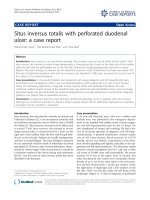Báo cáo y học: "Concurrent femoral neck fractures following pelvic irradiation: a case report" potx
Bạn đang xem bản rút gọn của tài liệu. Xem và tải ngay bản đầy đủ của tài liệu tại đây (552.53 KB, 3 trang )
BioMed Central
Page 1 of 3
(page number not for citation purposes)
Journal of Medical Case Reports
Open Access
Case report
Concurrent femoral neck fractures following pelvic irradiation: a
case report
Raphael Omotayo Ayorinde*
1
and Clement Abu Okolo
2
Address:
1
Department of Orthopaedic and Trauma, University College Hospital, Ibadan, Nigeria and
2
Department of Pathology, University of
Ibadan/University College Hospital, Ibadan, Nigeria
Email: Raphael Omotayo Ayorinde* - ; Clement Abu Okolo -
* Corresponding author
Abstract
Introduction: Fracture of the neck of the femur is common in older people. It often occurs in a
single hip, with osteoporosis being the most common cause. Sometimes this fracture may also
occur following pelvic irradiation, though this is not common. To the best of our knowledge, we
present the first reported case in Nigeria of concurrent bilateral fractures of the femoral neck
following pelvic irradiation.
Case presentation: A 74-year-old Nigerian woman presented at our surgical outpatients
department with a 5-month history of pain in both hips and a 4-month history of inability to walk.
She had had pelvic irradiation for carcinoma of the cervix 2 years earlier. Pelvic radiographs
confirmed bilateral subcapital neck fractures.
Conclusion: Patients with hip pain who have been treated with pelvic irradiation should be
thoroughly investigated for hip fractures.
Introduction
Hip fractures are common in older people and are a major
source of morbidity and mortality, especially in women.
Most of these fractures are related to osteoporosis and are
often precipitated by trivial injuries. However, it is well
documented that therapeutic radiation can result in bone
damage and may increase the risk of fracture [1]. Magnetic
resonance imaging and standard radiographs of the hips
are useful diagnostic tools [2]. We report a case of bilateral
femoral neck fractures presenting after radiotherapy for a
gynaecological malignancy.
Case presentation
A 74-year-old Nigerian woman was referred to our surgi-
cal outpatients department from the Radiotherapy
Department in September 2007 with a 5-month history of
pain in both hips and a 4-month history of inability to
walk. The pain had started in the right hip and involved
the left hip about a month later. The pain was insidious
and was associated with a worsening limp, which required
her to walk with the aid of a walking stick. She had been
bedridden for about 4 months before presentation but she
had no history of falls.
She had been diagnosed with a stage 1b invasive squa-
mous cell carcinoma of the cervix 2 years before presenta-
tion and was treated primarily with 45Gy of external
radiation therapy for 42 days in fractionated doses and
had been symptom-free thereafter. A pelvic radiograph
showed subcapital fractures of both femurs, with
osteonecrosis of the heads (Figure 1).
Published: 16 December 2009
Journal of Medical Case Reports 2009, 3:9332 doi:10.1186/1752-1947-3-9332
Received: 4 November 2008
Accepted: 16 December 2009
This article is available from: />© 2009 Ayorinde and Okolo; licensee BioMed Central Ltd.
This is an Open Access article distributed under the terms of the Creative Commons Attribution License ( />),
which permits unrestricted use, distribution, and reproduction in any medium, provided the original work is properly cited.
Journal of Medical Case Reports 2009, 3:9332 />Page 2 of 3
(page number not for citation purposes)
She underwent bilateral hemiarthroplasty with non-
cemented Austin Moore stems at 8-week intervals (Figures
2 and 3). The histology showed osteoporosis and necro-
sis, but no malignant cells. The patient is now pain free
and walks with a Zimmer frame.
Discussion
Radiotherapy is the mainstay of treatment of advanced
female pelvic malignancies, either in curative or palliative
settings [3]. The bony structures of the pelvis and groin lie
in close proximity to the genitourinary pelvic organs, gas-
trointestinal pelvic organs, and the lymphatic drainage of
these organs. Therefore, during irradiation, there is an
associated high rate of morbidity related to pelvic organs.
However, damage to the bones is rarely taken into
account, because they are relatively radioresistant. The
main evidence of the effect of irradiation on fracture risk
comes from a long-term follow-up study of two European
randomised trials (Stockholm I and II) evaluating the
effect of short-course irradiation in patients with operable
rectal cancer [4,5]. It was established that the patients who
underwent short-course irradiation were twice as likely to
be admitted to hospital with hip fractures as patients who
did not undergo irradiation.
Bilateral femoral neck fractures have also been reported in
the literature as resulting from long-term steroid therapy,
chronic renal insufficiency, in patients with abnormal
anatomy of the neck of the femur and as stress fractures in
young athletes [6-9]. Our patient, however, did not match
any of these conditions.
A search through the medical records in our hospital and
in our regional journals showed no patient presenting
with hip fracture following pelvic irradiation. This may
indicate that African blacks are less likely to develop pelvic
fractures following irradiation, although Nancy et al. [1]
did not find any statistical interaction between race and
irradiation therapy. Another reason could be that many of
our patients who had been treated may not have lived
long enough to develop radiation-induced fractures of the
hip. The late presentation and diagnosis of the hip frac-
tures in this patient is worthy of note. The patient pre-
sented with hip pain, for which she was treated with
analgesics only; no radiological investigation was done
until the patient was bed ridden. The rarity of this condi-
tion in our hospital may have been responsible for the
low index of suspicion. The presentation of this patient
fits into the classical symptom and signs suggested by LaV-
elle, "prodromal pain localised to the hip or radiating to
the knee, followed by a gradually increasing limp and dis-
ability, as might occur with a slipped femoral epiphysis.
Although the patient is able to walk, coxa vara deformity
may have already occurred" [10]. Hip pain in patients
Pre-operative antero-posterior radiographFigure 1
Pre-operative antero-posterior radiograph.
Pelvic radiograph after left hip hemiarthroplastyFigure 2
Pelvic radiograph after left hip hemiarthroplasty.
Pelvic radiograph after bilateral hip hemiarthroplastyFigure 3
Pelvic radiograph after bilateral hip hemiarthro-
plasty.
Publish with BioMed Central and every
scientist can read your work free of charge
"BioMed Central will be the most significant development for
disseminating the results of biomedical research in our lifetime."
Sir Paul Nurse, Cancer Research UK
Your research papers will be:
available free of charge to the entire biomedical community
peer reviewed and published immediately upon acceptance
cited in PubMed and archived on PubMed Central
yours — you keep the copyright
Submit your manuscript here:
/>BioMedcentral
Journal of Medical Case Reports 2009, 3:9332 />Page 3 of 3
(page number not for citation purposes)
treated with pelvic irradiation should make the physician
suspect radiation-induced insufficiency fractures of the
pelvis. In the study by Feltl et al. [3], all patients with
symptomatic pelvic bone fractures had pain as the first
symptom. The roentgenographic characteristics are well
described by Stephenson and Cohen [11] and suggest that
diagnosis of these fractures could be made on plain X-ray
before complete fractures occurred. Computed tomogra-
phy and magnetic resonance imaging [12] are also useful
in evaluating hip pain in patients treated with pelvic irra-
diation.
Conclusion
African blacks are predisposed to hip fractures following
pelvic irradiation. Hip pain in patients who have had pel-
vic irradiation should therefore be thoroughly investi-
gated for hip fractures. It should also be noted that
complications following irradiation may present months
or years later.
Consent
Written informed consent was obtained from the patient
for publication of this case report and any accompanying
images. A copy of the written consent is available for
review by the Editor-in-Chief of this journal.
Competing interests
The authors declare that they have no competing interests.
Authors' contributions
ROA managed the patient, conceptualised the write up,
and wrote the initial draft of the manuscript. CAO per-
formed the histological examination of the excised heads,
and was a major contributor to the manuscript, especially
the histological results. Both authors read and approved
the final manuscript.
References
1. Nancy NB, Elizabeth BH, Joel ET, Sara BD, Beth AV: Risk of pelvic
fractures in older women following pelvic irradiation. JAMA
2005, 23/30:2587-2593.
2. Zuckerman JD, Shin SS, Polatsch DB, Schweitzer M: Concurrent
bilateral femoral neck stress fractures and osteonecrosis of
the hip. J Bone Joint Surg 2006, 88:857-860.
3. Feltl D, Vosmik M, Jirasek M, Stahalova V, Kubes J: Symptomatic
osteoradionecrosis of the pelvic bones in patients with
gynaecological malignancies - result of a long-term follow-
up. Int J Gynecol Cancer 2006, 16:478-483.
4. Cedermark B, Johansson H, Rutqvist LE, Wilking N: Stockholm I
trial of preoperative short term radiotherapy in operable
rectal carcinoma: a prospective randomized trial. Cancer
1995, 75:2269-2275.
5. Stockholm Colorectal Cancer Study Group: Randomized study on
preoperative radiotherapy in rectal carcinoma. Ann Surg Oncol
1996, 3:423-430.
6. Haddad FS, Mohanna PN, Goddard NJ: Bilateral femoral neck
stress fractures following steroid treatment. Injury 1997,
28:671-673.
7. Tarr RW, Kaye JJ, Nance EP Jr: Insufficiency fractures of the fem-
oral neck in association with chronic renal failure. South Med
J 1988, 81:863-866.
8. Annan IH, Buxton RA: Bilateral stress fractures of the femoral
neck associated with abnormal anatomy - a case report.
Injury 1986, 17:164-166.
9. Bailie DS, Lamprecht DE: Bilateral femoral neck stress fractures
in an adolescent male runner - a case report. Am J Sports Med
2001, 29:811-813.
10. LaVelle DG: Fractures of hip. In Campbell's Operative Orthopaedics
Volume 3. 10th edition. Edited by: Canale ST. Philadelphia: Mosby;
2003.
11. Stephenson WH, Cohen B: Post-irradiation fractures of the
neck of the femur.
J Bone Joint Surg 1956, 38B:830.
12. Blomlie V, Rofstad EK, Talle K, Sundfor K, Winderen M, Lien HH:
Incidence of radiation-induced insufficiency fractures of the
female pelvis: evaluation with MR imaging. AJR Am J Roentegol
1996, 167:1205-1210.









